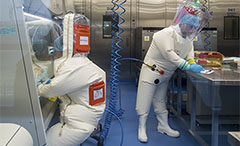Prevention, control of diseases improved
2017-03-22
China Daily
China’s capacity for the prevention and control of infectious diseases, and responding to emergency outbreaks has improved in the past eight years due to the implementation of a national project, according to the Ministry of Science and Technology.
Due to the project, China has established a vast national network for monitoring infectious diseases that covers 12 core national labs, 91 key regional labs and more than 800 hospitals across China, Qin Huaijin, head of science and technology at the National Health and Family Planning Commission, said on March 21.
China is now able to identify about 300 kinds of human pathogens within 72 hours, and an initial system to screen unknown pathogens has been established in China, said Qin, who is also chief supervisor of the project.
Some of the technologies used to test human pathogens in China are of a world-class level, he said.
The project, launched by the ministry and aimed at better control and prevention of major infectious diseases, including AIDS and hepatitis, was implemented in 2008 and will run through 2020.
“Before the project, testers and testing methods for many pathogens were lacking in China, and the country lagged far behind developed countries in terms of technologies,” said Kan Biao, deputy director of the Chinese Center for Disease Control and Prevention’s National Institute for Communicable Disease Control and Prevention.
Over the past eight years, scientists in China have identified new pathogens of great significance to public health, such as the H7N9 bird flu virus, cases of which have been reported in more than half of all provincial areas in China since late last year.
Chinese scientists have shared with the whole world their testing techniques for such pathogens, said Xu Jianguo, a leading expert in the study of infectious disease at the China CDC.
“Through integrating top resources for goal-oriented cooperation with the implementation of the project, China has made breakthroughs in key technologies in areas such as monitoring, testing and verification of pathogens, as well as emergency treatment of patients,” Qin said.
China has developed its own testers for HIV, which has improved testing efficiency and accuracy, and reduced the risk of HIV transmission, he said.
Due to optimized strategies for hepatitis B vaccination, the percentage of children under 5 years old carrying the hepatitis B virus in China has decreased to less than 1 percent, Qin said.
Members of the projects will intensify research in cutting-edge technologies used for testing and monitoring of infectious diseases, including technologies for testing new pathogens, so China is better equipped to prevent and fight infectious diseases, he said.
Xu said fighting infectious diseases is a common task for all countries, adding that increased international cooperation is expected over the next few years.


